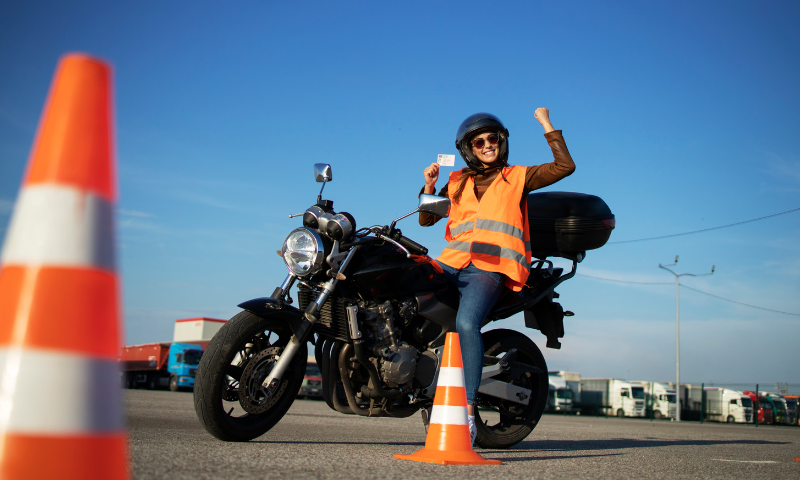Are you looking to hit the open road on a motorcycle? Before you do, you need to make sure that you have the right license. In this blog, we will guide you through the process of getting a motorcycle license in the UK – from understanding the different types of motorbike licenses available to passing your practical tests. We will also discuss important considerations for new riders, such as age and power restrictions, choosing the right training course, and whether the Direct Access Scheme (DAS) is an option for you. Lastly, we will highlight the perks of having a motorcycle license in the UK, from enjoying freedom on the road to opening up new opportunities. So, read on to find out everything you need to know about getting your motorcycle license in the UK!
Understanding the Different Types of Motorbike Licences in the UK
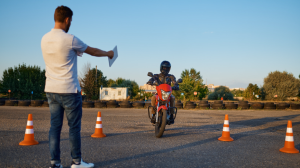
In the UK, there are different types of motorbike licences that you should understand before getting on the road. The first step is Compulsory Basic Training (CBT), which is required for all new riders. You can ride a moped or motorcycle up to 125cc with CBT with L-plates. Another option is the A1 Licence, which allows you to ride a motorcycle with an engine size of up to 125cc without L-plates. If you want more power, the A2 Licence permits you to ride a motorcycle with an engine size of up to 47 bhp. Finally, the A Licence is a full motorcycle licence that allows you to ride any motorcycle without restrictions. To obtain these licences, you must understand and pass practical and theory tests.
1. Provisional Licence: Your First Step
To begin your journey towards obtaining a full motorbike licence in the UK, the first step is to acquire a provisional licence. You must be at least 17 years old to apply for this licence, which can be done either online or by post through the DVLA. Once you have your provisional licence, you can start honing your riding skills on a motorbike. However, before taking your practical test for a full motorbike licence, passing the Compulsory Basic Training (CBT) course is mandatory.
2. AM Licence: For Mopeds and Light Quadbikes
The AM Licence enables individuals to ride mopeds and light quadbikes with a maximum speed of 28mph. Applicants must be at least 16 years old and must pass a CBT course and a theory test. Once obtained, the AM Licence is valid for life; however, individuals must remember to renew their CBT certificate every two years. It’s important to note that while this licence grants the ability to ride in both the UK and EU, riders must adhere to the respective local rules and regulations.
3. A1 Licence: For Small Motorbikes
An A1 licence allows riders in the UK to confidently ride light motorbikes with up to 11 kW (14.75 hp) power output and a power-to-weight ratio of no more than 0.1 kW/kg. To obtain an A1 licence, applicants must be at least 17 years old and successfully complete the Compulsory Basic Training (CBT), theory test, and practical test. After two years, A1 licence holders have the option to upgrade to an A2 or A licence without retaking the CBT or theory test. This licence is perfect for learners who want to build their road confidence before transitioning to more powerful motorcycles. Additionally, owning an A1 licence comes with lower insurance premiums and limited legal requirements.
4. A2 Licence: For Medium-sized Motorbikes
An A2 license in the UK allows riders to operate medium-sized motorbikes with a power output not exceeding 35 kW. To obtain an A2 license, individuals must be at least 19 years old and complete a CBT course and theory and practical tests. It’s worth noting that riding a motorbike with an A2 license comes with restrictions on the power output and modifications of the motorcycle. However, this license can be upgraded to an A license by completing additional training and tests.
5. A Licence: For Any Motorbike
The A Licence is the ultimate goal for motorcycle riders in the UK as it allows you to ride any motorbike without restrictions. To qualify for an A Licence, you must be at least 24 years old or have held an A2 Licence for a minimum of two years. The process involves a two-part test consisting of a theory and practical exam, where you’ll need to showcase your riding skills on a public road. Once you pass the test, you’ll be free to ride any motorbike on UK roads legally.
How to Get a Motorcycle License in the UK?
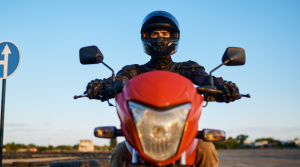
To obtain a motorcycle license in the UK, get a provisional one. Pass the theory and practical tests, which include off-road and on-road modules. Once you’ve passed both tests, apply for your full motorcycle license.
1. Application for Provisional Licence
To apply for a provisional motorcycle license in the UK, you need to be at least 16 years old and have a valid ID and proof of residency. The next step is to complete Compulsory Basic Training (CBT), including theory and practical training covering basic controls, road safety, and positioning. After completing the CBT, riders can ride motorcycles up to 125cc with L plates for up to 2 years. Further tests can be taken to obtain a full motorcycle license without restrictions.
2. Undertaking Compulsory Basic Training (CBT)
Undertaking Compulsory Basic Training (CBT) is a prerequisite for all prospective motorcyclists in the UK. This mandatory training course covers crucial riding skills, road safety knowledge, and motorcycle maintenance. Unlike other training programs, CBT can be completed in just one day and does not require any prior experience. Upon successful completion, riders are awarded a DL196 certificate, valid for two years. This certificate grants them the privilege to ride a learner-legal motorcycle on public roads.
3. Preparation for Motorcycle Theory Test
Preparing for the Motorcycle Theory Test is crucial for obtaining a motorcycle license in the UK. This test evaluates your knowledge of road rules and safe riding practices. To increase your chances of passing on your first attempt, it’s important to devote time to studying. You can utilize resources such as textbooks, online courses, and practice tests to enhance your understanding. Familiarizing yourself with the different types of questions that may appear on the test and practising mock tests will help build your confidence for the actual exam.
What to Expect from the Practical Tests? Module 1 and Module 2

Module 1 focuses on assessing your motorcycle handling and control skills within a controlled environment. It’s designed to ensure that you have the necessary abilities to ride safely on the road. On the other hand, Module 2 evaluates your road riding skills with an examiner following you on public roads. This module includes exercises like independent riding and emergency stops. Remember, both modules require a minimum standard of riding ability in order to pass. Training with an approved instructor can greatly help you prepare for these driving lessons.
Important Considerations for New Riders
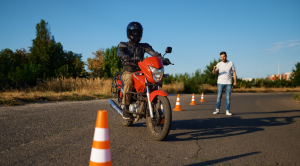
When obtaining a motorcycle license in the UK, there are several important considerations for new riders. Firstly, it’s essential to meet the age and eligibility requirements set by the DVLA. Understanding the different types of licenses available is also crucial, as it allows you to choose the one that suits your needs best. The process of obtaining a motorcycle license involves both theory and practical tests, including the hazard perception test. Safety should be a top priority for new riders, and wearing appropriate gear and taking training courses are key components. Lastly, maintaining your motorcycle and staying safe on the road is essential for a smooth riding experience.
1. Age and Power Restrictions
Age and power restrictions are in place to legally ride a motorcycle or moped in the UK. Riders must be at least 16 to ride a moped and 17 to ride a motorcycle. The power output of your motorcycle is also a factor in the type of motorcycle or moped license you need. If your motorcycle has a power output of over 125cc, you may require an A2 or full category A license. Training courses are recommended for new riders to ensure they are prepared for the road and understand all safety guidelines and regulations.
2. The Direct Access Scheme (DAS): An Option?
Considering the options to get a motorcycle license in the UK, the Direct Access Scheme (DAS) stands out. It allows you to take a test on a larger, more powerful motorcycle and grants you an unrestricted license upon passing. While it may be pricier and more time-consuming, some riders find it worth it.
How to Choose the Right Training Course?
When choosing a training course for your motorcycle license, there are several factors to consider. Firstly, think about the type of motorcycle you want to ride. Look for certified and reputable training schools in your area that provide both theoretical and practical training. It’s also important to check if the course includes the cost of the motorcycle test. Additionally, ask for referrals or read reviews from previous students to ensure you’re making the right choice. By carefully considering these factors, you can choose the right training course for your motorcycle license in the UK.
What are the Perks of Having a Motorcycle License in the UK?
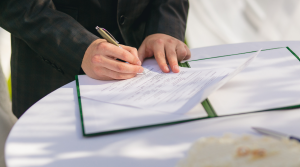
Having a motorcycle license in the UK comes with various perks. It allows you to experience the thrill of riding powerful vehicles and saves you time and money on your commute. Motorcycles are also more fuel-efficient, making them an eco-friendly choice. Additionally, owning a motorcycle connects you with other enthusiasts and offers opportunities for exploring new areas.
1. Freedom on the Road
Experience the joy of freedom on the road with a motorcycle license in the UK. Explore the beautiful British countryside and connect with its natural beauty in an intimate and immersive way. Say goodbye to traffic jams and enjoy the thrill of riding on winding roads and scenic highways. Not only will a motorcycle license improve your commuting time, but it will also save you money on fuel. Connect with like-minded individuals and join motorcycle clubs and events for an unforgettable adventure on two wheels.
2. A Door to New Opportunities
A motorcycle license in the UK opens up a world of possibilities. It allows you to effortlessly explore the countryside and save both time and money on your daily commute. Riding a motorcycle is an exhilarating experience that brings a new level of excitement to your life. With a motorcycle license, you can join clubs and social groups dedicated to the thrill of motorcycling. Not only that, but motorcycling is also a fantastic way to stay active and maintain good physical and mental health.
Benefits of Having a Motorcycle License in the UK
Having a motorcycle license in the UK comes with several benefits.
Firstly, it provides more transportation options and flexibility for commuting and leisure activities. With a motorcycle license, you can save money on fuel and parking costs, as motorcycles are generally more fuel-efficient and easier to park.
Additionally, a motorcycle license grants you access to motorcycle-specific roads and lanes, allowing faster and more convenient travel in congested areas. Riding a motorcycle also offers a sense of adventure and freedom, giving you the opportunity to explore new places and experience the thrill of the open road.
Lastly, obtaining a motorcycle license encourages the development of safe riding habits and skills through training and education, ensuring that you can enjoy the full benefits of motorcycling while staying safe on the road.
Conclusion
In conclusion, getting a motorcycle license in the UK opens up a world of freedom and opportunities. Whether you’re looking to explore the open road or navigate through congested city streets, having a motorcycle license gives you the ability to do so. It’s important to understand the different types of licenses available and the requirements for each. From obtaining a provisional license to undertaking the compulsory basic training and passing the practical tests, there are steps to follow to ensure you meet the necessary criteria. Additionally, it’s crucial to consider your age and any power restrictions that may apply and explore options like the Direct Access Scheme for faster license acquisition. By choosing the right training course and obtaining your motorcycle license, you will gain the benefits of increased mobility, exciting adventures, and the potential for new experiences on the road.





